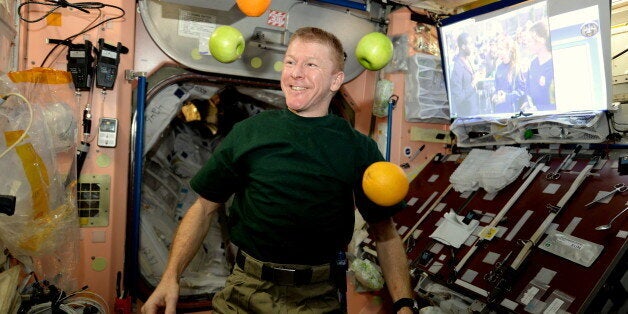
Thanks for all your comments and questions on social media, your interest is just fantastic. I've answered some of the most commonly asked questions, and listed them here. I'll try to answer more, but before posting new questions, please check through these to make sure I've not already covered that topic.

I like an accurate watch
1) What time zone do we use in space?
The Space Station runs to UTC (Universal Time Coordinated), which is basically GMT, luckily for ESA and those of you in UK. This time zone was chosen because it's 'in the middle' of all the International Space Station partners (USA, Canada, ESA, Russia and Japan) and each of the two main mission control centres, Houston and Moscow, gets to cover half a day shift.
2) Do we all sleep at the same time, and what time do we go to bed?
Yes, we sleep pretty much all at the same time. We try to get about eight hours of sleep per night, but this varies and we can go to bed anytime from 10 pm to midnight. I usually wake up at 6:30 am, which gives me time to prepare for the day's activities. While we're sleeping, mission control centres are monitoring the ISS systems. In case of an emergency, the ISS alarm would wake the crew and the Station Commander also has a radio speaker in their crew quarters.

Everybody can juggle in space
3) Is there gravity in space, and why do we appear 'weightless'?
This is a very common misconception that there is no gravity in space. Gravity is everywhere in space! It's what keeps the Moon in orbit around Earth, it keeps Earth in orbit about the Sun and holds galaxies together. So, why don't the Space Station or satellites fall to Earth, and why do we appear to be floating in the Space Station? That is because of our speed. We are not floating, we are actually 'falling'. But we do not fall to Earth because of our high speed, we fall 'around' Earth. We travel about 28 000 km/h (17 500 mph) but as we accelerate towards Earth under the pull of gravity, Earth curves away beneath us and we never get any closer. Since we have the same acceleration as the Space Station, we feel 'weightless'.
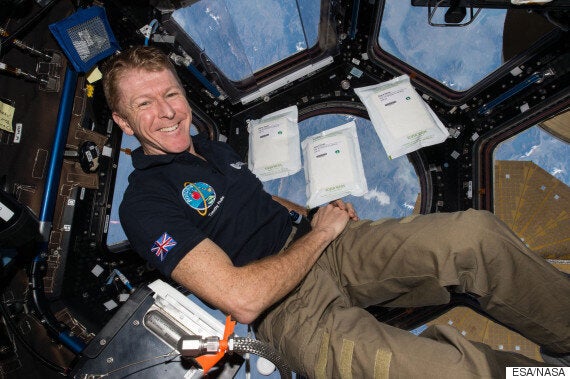
4) What does it feel like to float in space?
Floating in space is the most incredible feeling. It's actually very liberating not to be held down by Earth's gravity. I can look at something in the ISS 'ceiling' and just pop up there, turn upside down, pick it up, do a somersault and come back down again. We can store items on the walls and overhead without worrying about them falling down (Velcro is your friend here). It takes a while to get used to weightlessness and moving efficiently around the Station - but once mastered you can move around quickly with just the smallest of pushes. Imagine being able to travel down a long corridor on Earth without any effort - it would be great! We hardly use the soles of our feet at all - and because of this they become very smooth and soft - but we are constantly using the tops of our feet to grab under handrails and hold us down and so the skin becomes rough and hard on the tops of our toes.
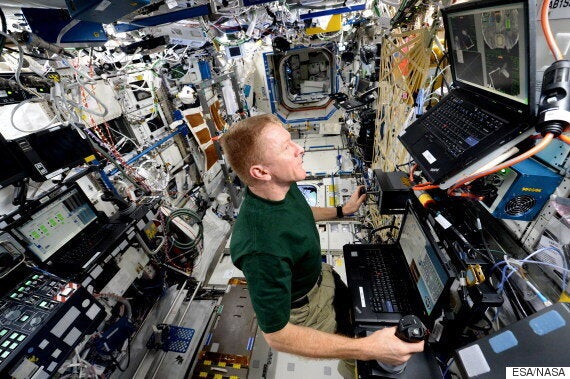
Same t-shirt as two pictures above - picture taken four days earlier (practicing Cygnus berthing).
5) How do we wash our clothes in space?
We do not have a washing machine so we wear the same clothes, including underwear, for several days before we change. It is not as bad as it sounds. We live in a temperature-controlled environment, so clothes do not get as dirty as they might on Earth. Some of the items, like socks or our exercise gear, have anti-bacterial materials in them. We change our exercise kit every 7 days. We change underwear every few days. Then we have polo shirts, T-shirts, trousers and shorts that last weeks. I'm still wearing the same pair of trousers I've worn since day 1... hmm maybe it's time for a change!
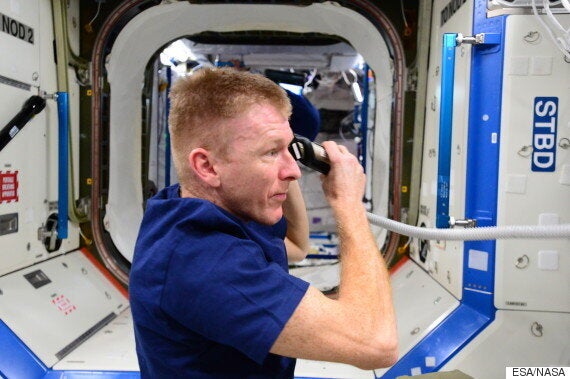
Space haircut
6) How do we cut our hair and shave in space?
We use a set of standard hair clippers for cutting hair. The only modification is that it is connected to a vacuum cleaner to suck up all the hair. I've been cutting my own hair just for fun and it's working out OK, but not something I will continue to do on Earth! For shaving, we use either electric razors, or regular razors with shaving cream. In using a regular razor though, you have to wipe the shaving cream off on a piece of tissue quite often. When using the electric, we shave in front of an air filter, and this catches the stray whiskers! I have a wet shave at the weekends and use an electric during the week.
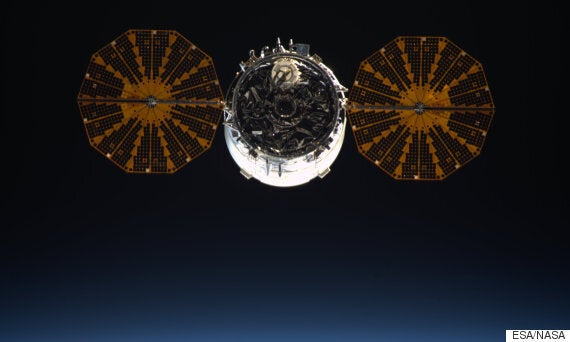
Cygnus CRS-5 leaving the Space Station 19 February 2016 with rubbish
7) What happens to waste from the Space Station?
Our used and dirty clothes are placed in a waste bag and put on a supply spacecraft (Progress or Cygnus) that undocks and then burns up in Earth's atmosphere. This is also how we get rid of other rubbish, such as empty food packaging or our solid waste from the toilet, for example. We don't get rid of urine - that is recycled back into drinking water.
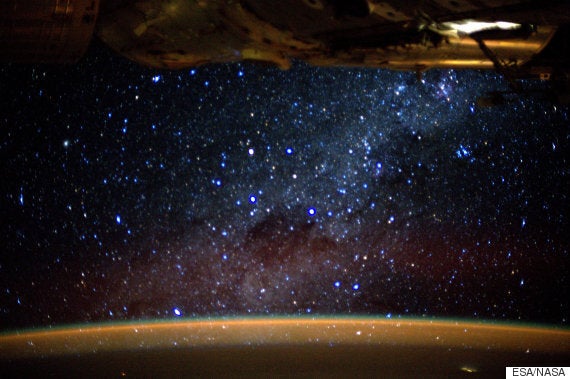
View of the Milky Way from the Space Station
8) Can I see stars and planets, and do they look different?
Yes, we can see stars and planets. We still see some twinkling of stars because of the vast amount of gas/dust in the Universe that starlight passes through. However, our atmosphere causes most of that 'twinkling' and makes the stars appear slightly less clear than when viewed from space. That's why you find many of the world's observatories on mountains tops - it's an attempt to reduce the amount of atmosphere that starlight has to travel through (and mountains tend to have less light pollution!).
Of course, we have no atmosphere outside our window, so it seems to me that the planets appear to be slightly brighter when viewed from up here - certainly Jupiter, Mars and Venus. What's also interesting is trying to judge distance. When Cygnus departed in February, we had the most spectacular view of it disappearing ahead of the Space Station and of course it got smaller as it got further away but it still looked very sharp and clear even at a distance, because there were no atmospheric obscurants in between. This made it harder to judge how far away it was.

9) Why are there no stars in my pics of Earth or my spacewalk?
The reason why you can't see stars in my daytime pics of Earth or my spacewalk is that, when lit by the Sun, any foreground objects, such as Earth, the Space Station or my spacesuit, are many thousands of times brighter than the stars in the background. Earth is so bright that it swamps out most if not all of the stars. The stars don't show up because the camera cannot gather enough of their light in a short exposure. Our eyes are a lot more sensitive to light than the cameras. To take pictures of stars, we need longer exposures on night-time parts of our orbit.
10) How many times will we go around Earth during our flight?
You can work this out for yourselves. First, you need to know how long we'll be in space. Let's say 170 days. Then you have to know that we have 16 orbits every day. So that's 170 x 16 = 2720 orbits.
11) How far will we travel during our time in space?
You know that we travel at 28000 km/h. Then you need to work out how many hours there are in 170 days. The distance will be 170 x 24 x 28000 = 114 240 000 km.
12) How long does it takes to get to the Space Station?
It takes a thrilling eight minutes and 48 seconds to be launched into space on our Soyuz rocket. Once in space we have to do a few things. First, we have to 'normalise' our orbit because it will be elliptical after insertion and we need to make it more circular. Then we need to raise our height up to about 400 km using something called a 'Hohmann transfer' and then we need to put the brakes on so that we match the ISS speed and height perfectly in time for docking. This all takes about six hours from launch.
13) Why don't you need a heat shield when leaving Earth, but only on reentry?
During launch, we gain altitude at relatively low velocity at first, but by the time we hit the high Mach numbers, we're already in space so there's no air to cause frictional heating. During reentry, we have no choice but to use the atmosphere to slow us down, all the way from Mach 25 (28000 km/h), and that creates a lot of heat.
14) Did you always want to be an astronaut??
As a young boy I was always fascinated by the stars and the Universe. When it came to a career choice though I was passionate about flying and could not wait to train as a pilot. I spent 18 years flying all types of helicopters and aircraft and eventually trained as a test pilot. I followed the space programme closely and when the European Space Agency held its selection for astronauts in 2008 I was ideally placed to apply.
15) What food do you eat in space??
We eat fairly normal food, like you might eat on Earth, but it is out of cans or packets. Some of it is dried food to which we add water to make it edible. Other (irradiated) food comes in pouches which we place in our electrical food heater to warm up. It's not too bad, but we try not to eat too much salt in space as it can exacerbate the loss of bone density and so the food can sometimes be a bit bland. The portions are also quite small so you have to be careful not to lose too much weight... a great excuse for eating dessert every night! My favourite foods are the breakfast menus (scrambled eggs, baked beans and sausages!). We also get a very small supply of fresh fruit every so often on the supply spacecraft.
16) How can you eat food in weightlessness? Doesn't it float back up?
You can swallow and digest food just fine in space. Digestion relies on different muscles in your body that squeeze behind the food you eat, pushing it through you until it's safely in your stomach. This is called 'peristalsis'. Once the food is in your stomach, you have various valves that keep food in place. However, after a meal you can definitely feel that your food sits more 'lightly' in your stomach and I learnt the hard way that you shouldn't run on the treadmill for at least an hour or two after eating!
17) Is it true that you lose your appetite in space?
Not really, but the sense of smell is incredibly important when it comes to both generating a desire to eat and tasting food. In weightlessness, food aromas don't hang around in the same way they do on Earth. Salt and pepper (which are suspended in liquid to stop the particles floating away), and other condiments are used to enhance the flavour. But our ability to taste food is affected in another way. Because fluids inside us shift towards the centre of our bodies and, in particular, our heads, we get tend to feel like we have stuffy noses, making it more difficult to smell food.
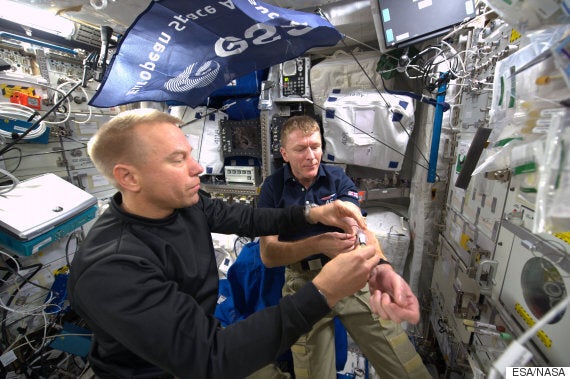
Tim Kopra drawing blood for marrow experiment
18) What would happen if someone got sick or injured in space?
All astronauts are trained to a very high level in first aid. In addition, there are always at least two Crew Medical Officers (CMOs) on board that can deal with basic surgical procedures, such as filling teeth or suturing, for example. Both Tim Kopra and I are trained CMOs. We also have a medicine cabinet, which is like a small pharmacy, containing everything from analgesic painkillers and antihistamines to sleep aids, all the way up to antibiotics and local anaesthetics. We also have an Automated External Defibrillator (AED) on board for resuscitation and we have procedures that include using a spacesuit as a personal pressure chamber if we needed to treat a crewmember suffering from 'the bends' following a spacewalk. If we developed a serious illness, like appendicitis for example, the situation would be assessed by our doctors on the ground whether it would be better to stay on board and use medication, or to return to Earth (appendix removal is not standard procedure for astronauts prior to flight).
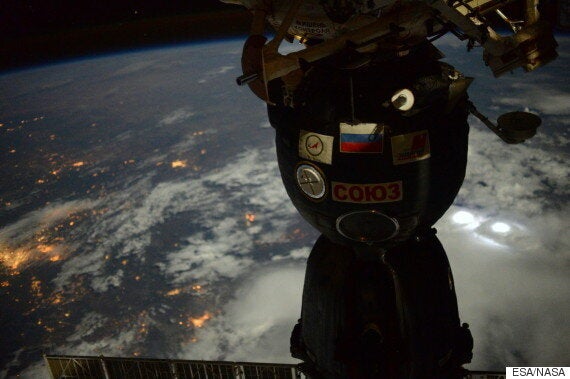
Soyuz spacecraft and 'lifeboat' docked to the Space Station
19) What would happen if there was a fire on the Station?
We've already had a couple of emergency fire warnings since I have been on board but thankfully both turned out to be false alarms. However, we treat every situation as a real emergency of course. Fires can vary between open fires (visible flame), smoke, smell of burning, or just a smoke detector alarm but no other indications. We have procedures that deal with each case depending on the severity of the situation. In the most serious cases, we would don breathing apparatus and fight the fire using either carbon dioxide, water mist or foam fire extinguishers. We would also try and locate the power source and remove electrical power (electricity is most likely to be the cause of a fire on board). The smoke detectors trigger an automatic response from the ISS to shut down all ventilation systems, so as not to feed oxygen to the fire and to reduce the spread of smoke throughout the station. We have special detectors that tell us if the air is contaminated with carbon monoxide and other harmful gases - these are used to know when it is safe to remove our breathing masks. We also have special filters and equipment on board to clean and scrub the atmosphere to return the ISS back to full health. Only as a last resort would we evacuate the ISS in our Soyuz spacecraft. Interestingly, the Soyuz does not have any fire extinguishers. The way to fight a fire in the Soyuz is to close your helmet and depressurise the whole spacecraft... no oxygen = no fire!
